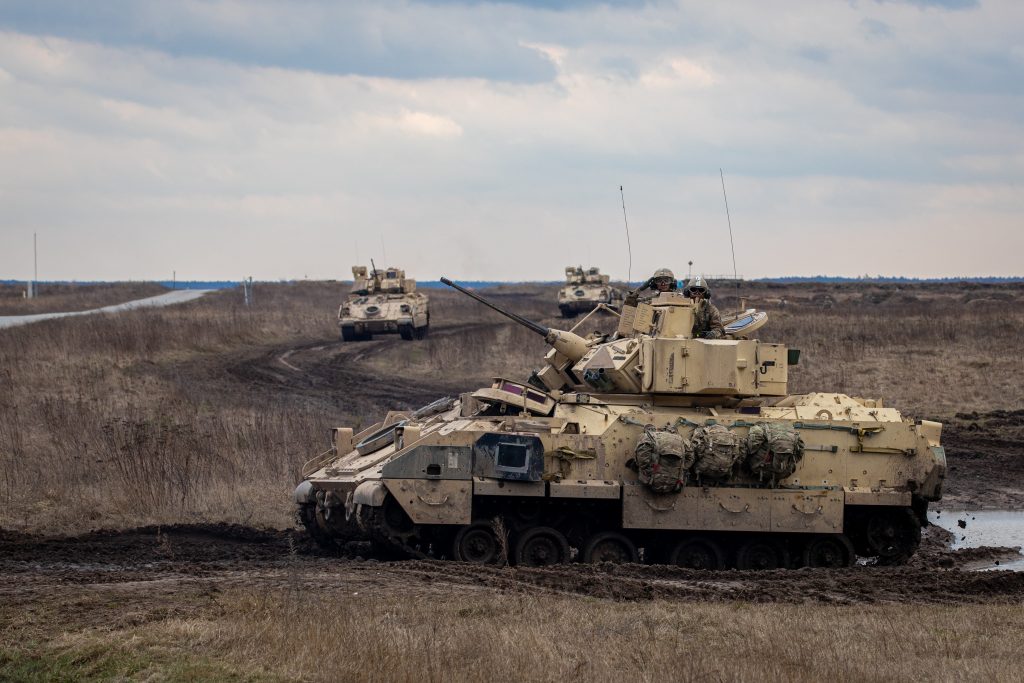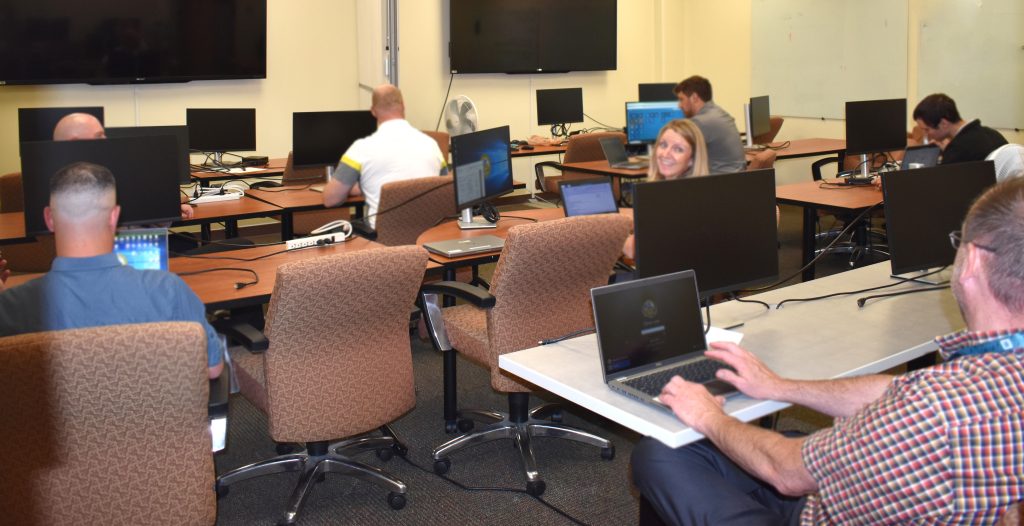
XM30 COMBAT VEHICLE: The XM30 Mechanized Infantry Combat Vehicle, shown here in a conceptual illustration, will be the Army’s replacement for the aging M2 Bradley Fighting Vehicle. (Image courtesy of PM XM30)
PEO GCS receives training on emerging digital design efforts and the digital acquisition strategy in the XM30 combat vehicle program.
by Macam Dattathreya, Ph.D., Col. Jeffery W. Jurand and Steven A. Dawson
The XM30 Mechanized Infantry Combat Vehicle, developed to replace the aging M2 Bradley Fighting Vehicle, is the first ground vehicle to fully adopt modern digital engineering tools and processes to design, test through simulation and iterate a full vehicle design before building prototypes. This model-based approach is heavily reliant on the workforce understanding the systems modeling language and applying the principles of the Ground Combat Systems common infrastructure architecture (GCIA)—the modular open-systems approach (MOSA) standard for the Program Executive Office for Ground Combat Systems (PEO GCS).
To train the workforce, the assistant PEO for systems engineering and integration (APEO SEI), in collaboration with Project Manager XM30 Combat Vehicle (PM XM30), spearheaded on-the-job training for the XM30 team. The curriculum was specifically designed to train team members on how to read digital system architecture contract deliverables to ensure that contractors are meeting MOSA and GCIA requirements.
To be successful, the workforce must align training efforts with the emerging digital engineering and MOSA trends for the XM30 program. Using government-led micro instructional sessions—a teaching technique that involves breaking down lessons into smaller, more manageable parts—enables the XM30 workforce to read and understand digital system architecture contract deliverables. There have been 14 training sessions conducted across three cohorts so far, resulting in 25 trained employees. The success of this training approach has spurred the addition of more cohorts and at least 10 more sessions through the end of fiscal year 2023.

REPLACEMENT ON ORDER
Soldiers assigned to 2nd Armored Brigade Combat Team, 1st Cavalry Division, NATO eFP Battle Group Poland, maneuver M2 Bradley Fighting Vehicles during a platoon live fire exercise at Bemowo Piskie, Poland, in March. The U.S. Army Optionally Manned Fighting Vehicle, now officially named the XM30, will replace the Bradley Fighting Vehicle. (Photo by Sgt. Lianne M. Hirano, 117th Mobile Public Affairs Detachment)
THE NEED FOR A DIGITAL ACQUISITION WORKFORCE
Developing a digital acquisition workforce is key to meeting two goals: complying with the new law requiring a modular open-system approach in major defense acquisition programs and DOD’s drive toward digital engineering within acquisition. Using a formalized, model-based systems engineering approach achieves both these goals. First, it provides experts to identify the data necessary to address the challenges, opportunities and requirements to realize the MOSA objectives—incremental development, enhanced competition, innovation and interoperability. Second, it provides the training, tools and infrastructure needed to extract, contextualize and analyze that data.
The key tenets of digital engineering are establishing an authoritative source of truth for the system, ensuring that all system data (requirements, engineering, test, logistics, cost and software data) are always aligned, and more importantly, making the models accessible to project management office staff for review to ensure contract compliance. Combining digital engineering principles and model-based systems engineering enables programs to demonstrate compliance with the MOSA statutory requirements. The synchronization of models inherent in a digital engineering approach will provide unparalleled insight into design activities as well as support verification and validation of performance requirements. However, to realize the benefits of this approach, each project office must train its workforce to use and understand digital models.
TRAINING THE WORKFORCE
Systems engineering models can wield enormous amounts of information about the structure and properties of a design. Employed properly, they allow decision-makers to dynamically select, organize and process data to inform all kinds of detailed design and programmatic analyses.
But building and validating that the models are sufficiently detailed, and that the data is appropriately indexed, managed, compiled and presented reliably enough to inform potentially multibillion-dollar decisions, requires a cadre of engineers, logisticians, testers and program managers with practical experience in model-based systems engineering.
As one of the first major defense acquisition programs to use a model-based digital engineering approach, PM XM30 lacked that cadre of professionals with practical experience in model-based systems engineering. The PM XM30 organization selected experts to work on the model, but they were not yet trained on how to read and digest data from a model. Additionally, the few employees who were well versed in model-based systems engineering did not have the required knowledge about the combat vehicles themselves.
To address this knowledge gap, APEO SEI and PM XM30 assembled a small team with knowledge about both combat vehicles and model-based systems engineering, and then looked to academia and industry for educational resources. Unfortunately, those resources were focused heavily on either theoretical or very specific applied aspects with no applicability to the day-to-day operations the PM XM30 workforce needed to manage a combat vehicle developmental project.
To meet the project needs, APEO SEI and PM XM30 developed training that was focused on learning how to read models, and then how to specifically evaluate designs for compliance with the MOSA and GCIA standards, within the context of a ground combat vehicle. This on-the-job training paves the road, one mile at a time, to the future digitally aware workforce required to manage models-based, open-architected programs like the XM30, the Robotic Combat Vehicle and future acquisition programs.
|
WHAT’S DIGITAL ENGINEERING? According to the Office of the Under Secretary of Defense for Research and Engineering, digital engineering is an integrated digital approach using authoritative sources of system data and models as a continuum throughout the development and life of a system. Digital engineering updates traditional systems engineering practices to take advantage of computational technology, modeling, analytics and data sciences. |
The approach taken at PM XM30 has students learn topics through a gradual introduction of related concepts in small iterations of instructor-led discussions. The students then apply those concepts in hands-on practical exercises, reviewing system architecture models to reinforce learning. The instruction is done with the system architecture model with sufficient detailed design information, as compared with the conceptual level (i.e., requirements) or physical level (i.e., computer-aided design drawings or three-dimensional models of a system), to focus the learning on the principles of a model-based approach to design. Each block of instruction is narrowly focused on a modeling concept, then uses a specific area of ground combat vehicle design (i.e., electronics, software, MOSA) for practical exercises. To pilot the training, PM XM30 provided 10 engineers to participate in six or more three-hour sessions over multiple weeks. This group provided invaluable feedback on course design and topics, allowing the instructors to improve the course for subsequent classes.
The classes have now matured into one three-hour session a week, where students are expected to do some pre-reading focused on areas critical to ground combat vehicle design (e.g., architecture, computing, network, safety, cyber). The reading materials allow the course to focus more on practical exercises and less on lectures. Students summarize their learning in their own way and the course instructors discuss the student’s summary and conduct model reviews of student work to assess their understanding, before revealing answers and discussing conflicts. Practical exercises over the course of the class use a gradual release concept. The first two classes are heavily structured and led by the instructors, with subsequent classes pairing students for the practical exercises. The final classes require the students to complete the practical exercises independently. This approach helps students navigate through the concepts slowly, methodically and incrementally, using a ground combat vehicle system architecture model to help explain MOSA principles and model-based systems engineering concepts.

WORKFORCE TRAINING
Students participate in an interactive training session at the PM XM30 office in Warren, Michigan. (Photo courtesy of PM XM30)
CONCLUSION
DOD’s push for digital acquisition, along with the new MOSA statute, requires modern skills within the acquisition workforce, while retaining the irreplaceable expertise of our acquisition workforce. Building a digital engineering and MOSA-enabled workforce requires training current employees to employ new tools, modeling languages and approaches. Using best-of-breed academic and industry training, along with specific practical examples from ground combat vehicles, is key to quickly building competency within PM XM30 and the larger PEO GCS workforce.
A road to a digitally aware workforce, one mile at a time, is exclusive and probably the first ever training approach employed within the Army to train their workforce on the model-based training with MOSA. Using this unique government-led, -developed and -instructed training enables the workforce to learn and be useful quickly through streamlined and context-based education. APEO SEI intends to partner with the U.S. Army Combat Capabilities Development Command Ground Vehicle Systems Center to incorporate the training into workforce development to support propagation of the newly developed skills.
For more information, contact Macam Dattathreya, Ph.D., at macam.s.dattathreya.civ@army.mil.
MACAM DATTATHREYA, Ph.D., is the chief engineer for PEO GCS and has 30 years of work experience in multiple engineering fields across commercial and public sectors. He earned a Ph.D. in electrical and computer engineering and an M.S. in computer engineering, both from Wayne State University, and a bachelor of engineering in industrial and production engineering from Sri Jayachamarajendra College of Engineering in India. He is a Certified Information Systems Security Professional and holds the DAWIA Foundational certification in engineering and technical management.
COL. JEFFERY W. JURAND is the project manager for the XM30 Combat Vehicle at PEO GCS and a basic branch armor officer in the U.S. Army. He holds an M.S. in engineering management from the University of Maryland, a B.S. in engineering science from Vanderbilt University and he studied cybersecurity and artificial intelligence through the U.S. Army War College Senior Service College Fellowship at Carnegie Mellon University.
STEVEN A. DAWSON is the assistant program executive officer for systems engineering and integration at PEO GCS. He has 34 years of experience in engineering support and program management for Combat Support and Combat vehicle systems at the Detroit Arsenal. He last served as the engineering director to the Project Manager Stryker Brigade Combat Team. He holds an M.S. in program management from the Naval Postgraduate School, a Master of Strategic Studies from the Army War College and a B.S. in mechanical engineering from the University of Maryland.
CONTRIBUTORS:
Aaron Hart, product director, Light Tactical Vehicles
Maj. Robert Pedrigi, assistant program manager, PM XM30
Benjamin A Steadman, senior systems engineer, PEO GCS and Ricardo Defense Inc.







